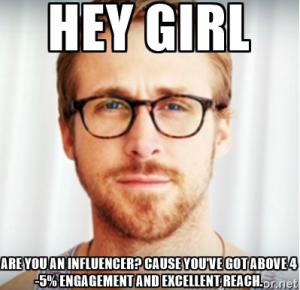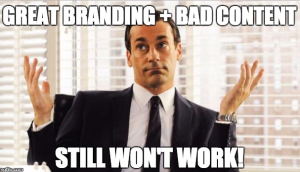Digiday announced the “rise of ‘micro-influencers’” in April 2016. This week, the site had an article that forecasted imminent doom for the micro-influencer market. What a difference a couple of months makes.
There’s no clear consensus, but Digiday, at least, defines micro-influencers as non-celebrity content producers with 10,000 to 100,000 followers, paid by brands to post about products (Chen, 2016). Posting content isn’t typically what micro-influencers do for a living—unlike the big-time influencers—it’s instead a side gig. And micro-influencers tend to post less frequently than big-time celebrity endorsers (Chen, 2016). So to some, a micro-influencer’s content has a little more street cred and authenticity.
I offer now an extremely rudimentary summation of the trajectory of influencers, because it speaks to how fickle and flashy their trajectory has been. I think it goes something like this: Malcolm Gladwell, in his 2000 book The Tipping Point, was first to described them. They were key people in networks, prominent people who could move the opinion of a community (Jenkins, Ford, & Green, 2013). Gladwell called them both mavens and influencers, and (shock) “influencers” was the name that stuck.
Influencer theory was, and is, debated by academics, but marketers grabbed it and haven’t let go—because the sway of recommendations from peers has surpassed that of recommendations from the brands themselves (Jenkins, et al., 2013).
An influencer’s clout was initially determined by number of followers, but marketers soon started looking at engagement too, conveyed in this equation (Wong, 2014):
Influence = Audience Reach (# of followers) x Brand Affinity (expertise and credibility) x Strength of Relationship with Followers
Some still sing the praises of influencer marketing—that it’s earning brands $6.50 for every $1 spent (Goldstein, 2016). These chipper marketers believe that it’s best done in blogs, followed by Facebook posts (Goldstein, 2016).
Analytics, however, have begun to reveal a point at which, if an influencer’s followers numbers get too high, engagement drops off (Caffyn, 2016). Like a reverse tipping point! The middle road influencers flourished—that new league of content wizards who built communities on topics like fashion, beauty, food, and parenting. Their organic engagement outperformed influencers who had more than 100,000 followers (Chen, 2016).
But like a lot in Web 2.0, the boom times can fold in on themselves, and that, according to a recent Digiday “Confessions” post, is what’s afoot now with micro-influencers. Strike one: Influencer platforms are throwing money at a lot of content producers, and some of that content is crap (Caffyn, 2016). Strike two: Our obsession with an influencer’s number of followers is waning. Strike three: Engagement analytics have been fuzzy for a long time, and they’re getting harder to fake, which a lot of influencers apparently do (Caffyn, 2016).
It seems like time, and analytics, first took a bite out of the big influencers, and now they might be poised to take a bite out of the micro-influencers too. I think the anonymous agency exec from Digiday’s “Confessions” series was probably right, as sad as I am to see good content producers lose an income stream: Influencer marketing is “another Wild West. Soon there will come a point where this bubble of people being paid for product placement will burst.”
References:
Caffyn, G. (2016, October 7). Confessions of an influencer agency exec on micro-influencers: ‘It’s all going to implode’. Retrieved October 8, 2016, from http://digiday.com/brands/confession-micro-influencer-bubble/
Chen, Y. (2016, April 27). The rise of ‘micro-influencers’ on Instagram. Retrieved October 8, 2016, from http://digiday.com/agencies/micro-influencers/
Goldstein, J. (2016, May 21). Influencer marketing: Worth it or a waste? Retrieved October 8, 2016, from http://www.business2community.com/marketing/influencer-marketing-worth-waste-01549023#mqwprM19J6prABIo.97
Jenkins, H., Ford, S., & Green, J. (2013). Spreadable media: Creating value and meaning in a networked culture. NYU press. Chicago
Wong, K. (2014, September 10). The explosive growth of influencer marketing and what it means for you. Retrieved October 8, 2016, from http://www.forbes.com/sites/kylewong/2014/09/10/the-explosive-growth-of-influencer-marketing-and-what-it-means-for-you/#305072fe595f



6 Responses to Micro-Influencers, Enjoy That Sweet Cash While You Can